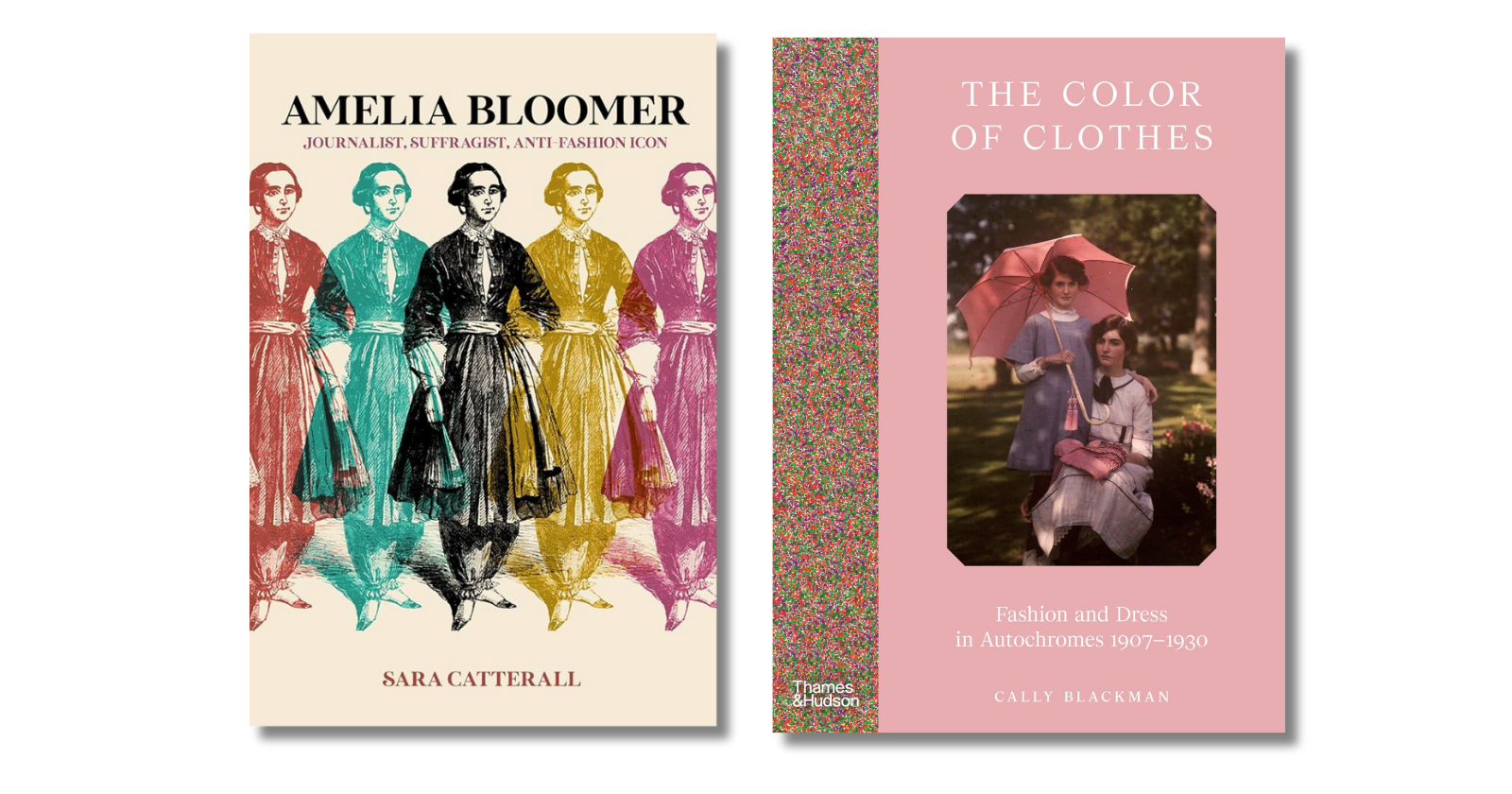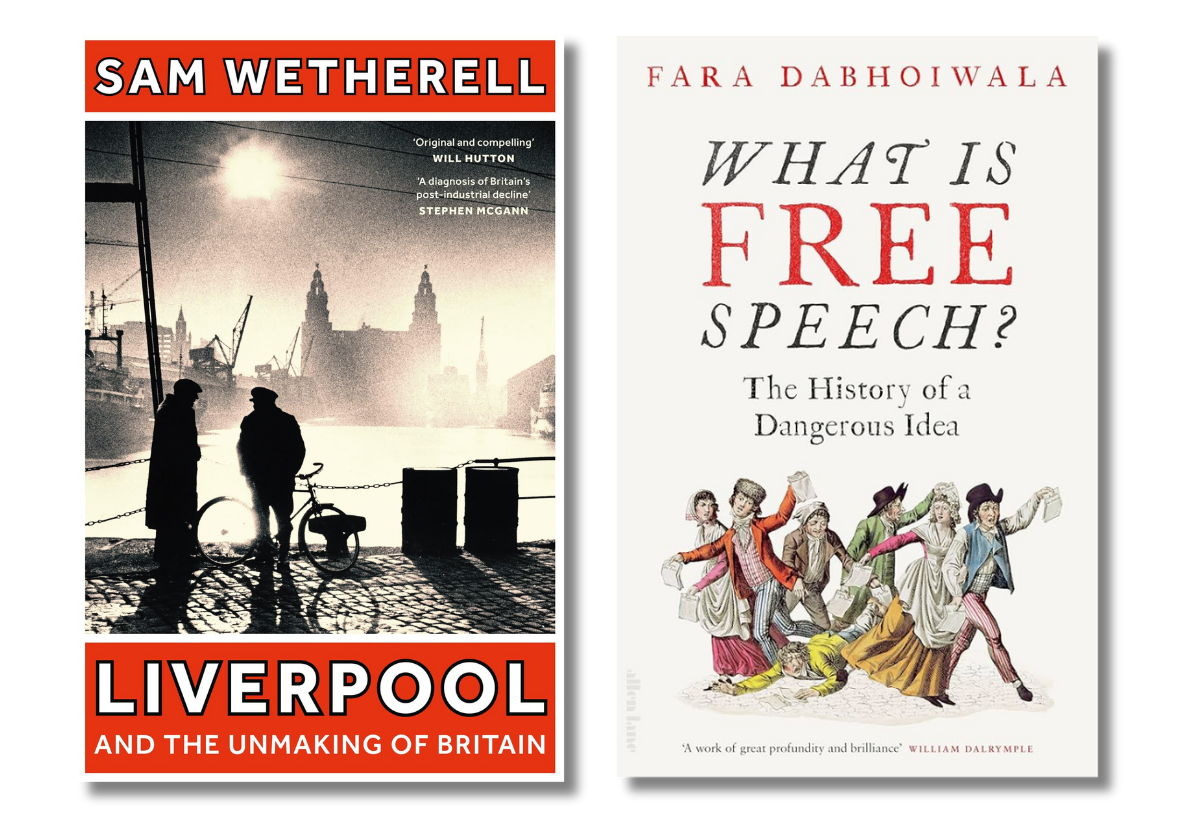
‘This is much more than the history of a place’
Erik Linstrum is Professor of History at the University of Virginia
Sam Wetherell’s Liverpool and the Unmaking of Britain (Head of Zeus) is a mesmerising panorama of the postwar, postimperial, postindustrial city as a vision of the British future. Forget about ‘decline’, Wetherell argues, with its nostalgic tinge and neglect of inequality; Liverpool is a case study in ‘obsolescence’. Drawing on forgotten stories of mass deportations, tropical diseases, shipping containers, and, yes, the Beatles, this is much more than the history of a place. It is a portrait of the multiracial working class, stranded in the wreckage of a pitiless political economy.
In What Is Free Speech? The History of a Dangerous Idea (Allen Lane), Fara Dabhoiwala poses a simple question about the principle beloved by culture warriors. Stopping in London’s Grub Street, New World slave plantations, Enlightenment-era Scandinavia, and British-ruled India, he shows that free speech has never been much of a principle at all. Rather, it has been a polemical weapon and an ambiguous slogan, riddled with hypocritical loopholes in practice, that has only ever made sense as a means to higher ends. The pursuit of truth – not speech for its own sake – should be our lodestar.
-
Liverpool and the Unmaking of Britain
Sam Wetherell
Head of Zeus, 448pp, £25
Buy from bookshop.org (affiliate link) -
What Is Free Speech? The History of a Dangerous Idea
Fara Dabhoiwala
Allen Lane, 480pp, £30
Buy from bookshop.org (affiliate link)

‘One of his generation’s leading archival, narrative historians of modern China’
Julia Lovell is Professor of Modern Chinese History & Literature at Birkbeck, University of London
I loved Stephen R. Platt’s The Raider: The Untold Story of a Renegade Marine and the Birth of U.S. Special Forces in World War II (Knopf), a biography of Evans Carlson. We live in an era when engagement with China in the anglophone world is riven with political polarities. Carlson (1896-1947) was a pioneering, controversial Marine intelligence officer during the 1930s and 1940s, whose interactions with the rising Chinese Communist Party offer, in microcosm, a history of modern America’s fraught relationship with China. Platt is one of his generation’s leading archival, narrative historians of modern China, and he brings the era to life in grippingly vivid prose.
I was also enthralled by the paperback edition of Jessica Rawson’s Life and Afterlife in Ancient China (Penguin). Drawing on some 50 years of immersive study of material life and burials in Chinese antiquity, the book interprets – in elegant, accessible language – an archaeology that is fascinatingly distinct from that of the Egyptian and classical European worlds. Analysis of deep history remains crucial to contemporary Chinese identity; this richly evidenced book is an essential guide to society, belief, and economy during a foundational period of China’s development.
-
The Raider: The Untold Story of a Renegade Marine and the Birth of U.S. Special Forces in World War II
Stephen R. Platt
Knopf, 544pp, £30
Buy from bookshop.org (affiliate link) -
Life and Afterlife in Ancient China
Jessica Rawson
Penguin, 560pp, £16.99
Buy from bookshop.org (affiliate link)

‘A brilliantly witty “autobiography”’
Paul Cartledge is A.G. Leventis Professor of Greek Culture Emeritus at the University of Cambridge
Pride of place must go to a superb fresh translation of Thucydides’ History of the Peloponnesian War by nonpareil translator Robin Waterfield with introduction and notes by Polly Low (Basic Books). Thucydides may not be everybody’s ‘Father of History’, but his many fans are determined to vindicate his immodest claim to have written ‘an acquisition for all time’.
In humorous vein, Peter Acton has composed a brilliantly witty ‘autobiography’ ostensibly by an Athenian comic poet-dramatist (and younger contemporary of Thucydides), Aristophanes son of Philip: Clouds, Birds, Frogs and Me (Vanguard Press).
James Romm, series editor of Yale University Press’ ‘Ancient Lives’, is himself a biographer of distinction. His Plato and the Tyrant (W.W. Norton) is a rare biographical portrait of (non-democratic) Athenian philosophical supremo Plato in incongruous and ineffectual intercourse with the strong man of Sicily, Dionysius I of Syracuse. Lessons for today? As often, yes, many. Connoisseurs of Xenophon’s Hiero dialogue (another of Waterfield’s translated masterpieces) will understand.
-
The History of the Peloponnesian War
Thucydides (translated by Robin Waterfield)
Basic Books, 752pp, £35
Buy from bookshop.org (affiliate link) -
Clouds, Birds, Frogs and Me
Peter Acton
Vanguard Press, 340pp, £12.99
Buy from bookshop.org (affiliate link) -
Plato and the Tyrant
James Romm
W.W. Norton, 368pp, £25
Buy from bookshop.org (affiliate link)

‘Emphasises the historical battle in the US between physical force and moral persuasion’
Susan-Mary Grant is Professor of American History at Newcastle University
On the surface these three books appear to have little in common. Jill Lepore’s We the People: A History of the US Constitution (John Murray) traces the history of constitutional amendment and the significance of the constitutional tradition to the American state. Rhodri Jeffreys-Jones’ Allan Pinkerton: America’s Legendary Detective and the Birth of Private Security (Georgetown University Press) focuses on a famous detective agency, its founder, and the earliest iterations of private security in the service of the state. And Ferdinand Mount’s Soft: A Brief History of Sentimentality (Bloomsbury) considers the formative significance of an emotion in Britain from medieval times onwards, with the occasional foray across the Atlantic.
In fact, each has a lot to tell us about the others. Lepore’s study draws out the wider implications of amendment in the sense of to mend, or repair. She, like Jeffreys-Jones, emphasises the historical battle in the US between physical force and moral persuasion. And Mount draws out the links between moral persuasion and sentiment, reminding us that change comes from choice, and choice in history has often had a sentimental inflection.
-
We the People: A History of the US Constitution
Jill Lepore
John Murray, 720pp, £30
Buy from bookshop.org (affiliate link) -
Allan Pinkerton: America’s Legendary Detective and the Birth of Private Security
Rhodri Jeffreys-Jones
Georgetown University Press, 328pp, £24
Buy from bookshop.org (affiliate link) -
Soft: A Brief History of Sentimentality
Ferdinand Mount
Bloomsbury, 320pp, £20
Buy from bookshop.org (affiliate link)

‘An illuminating snapshot of editing as care work’
Marlene L. Daut is Professor of French and Black Studies at Yale University
Dana A. Williams’ Toni at Random: The Iconic Writer’s Legendary Editorship (Amistad) is not just a biography of the inimitable author of Beloved, Song of Solomon, and The Bluest Eye, but a compelling portrait of Toni Morrison’s time as a senior editor at Random House in the 1970s and early 1980s. Morrison’s careful stewardship of writers including Angela Davis, Toni Cade Bambara, Lucille Clifton, and Gayl Jones presents an illuminating snapshot of editing as care work.
Ryan Hanley’s Robert Wedderburn: British Insurrectionary, Jamaican Abolitionist (Yale University Press) tells the story of a mixed-race radical activist from colonial Jamaica, the freed child of an enslaved woman, Rosanna, and her Scottish enslaver. Focusing on Wedderburn’s famous antislavery newspaper The Axe Laid to the Root (1817), Hanley traces how the memory of the beatings Wedderburn’s mother and grandmother suffered at the hands of white men – painstakingly described by Wedderburn in his autobiographical The Horrors of Slavery (1824) – drove his many crusades to defend the oppressed and downtrodden in England and its colonies.
-
Toni at Random: The Iconic Writer’s Legendary Editorship
Dana A. Williams
Amistad, 368pp, £25
Buy from bookshop.org (affiliate link) -
Robert Wedderburn: British Insurrectionary, Jamaican Abolitionist
Ryan Hanley
Yale University Press, 248pp, £18.99
Buy from bookshop.org (affiliate link)

‘Explores how interpretations of Rome’s physical remains shift with time and belief’
Stefan Bauer is Research Integrity Facilitator at King’s College London
The election of a new pope is always an unpredictable leap. In Jesus Wept: Seven Popes and the Battle for the Soul of the Catholic Church (Knopf), Philip Shenon revisits recent papacies, though his moralising division between ‘good’ reformers and ‘bad’ conservatives oversimplifies matters. Still, his vivid accounts of Vatican II, abuse investigations, and the global enthusiasm for Francis allow us to reflect on Leo XIV’s options.
Historians now agree that the Roman Inquisition was less despotic than once believed, bound by strict procedure and limited use of torture. Stefania Tutino’s 1626: A Year in the Life of the Roman Inquisition (Oxford University Press) goes further, revealing the Inquisitors’ own struggle between rule and discretion as they handled cases touching on sex, money, doctrine, and politics. Similarly, Roland Mayer’s The Ruins of Rome: A Cultural History (Cambridge University Press) explores how interpretations of Rome’s physical remains shift with time and belief – few today would share Byron’s notion of their ‘ruinous perfection’.
-
Jesus Wept: Seven Popes and the Battle for the Soul of the Catholic Church
Philip Shenon
Knopf, 608pp, £30
Buy from bookshop.org (affiliate link) -
1626: A Year in the Life of the Roman Inquisition
Stefania Tutino
Oxford University Press, 448pp, £98.90
Buy from bookshop.org (affiliate link) -
The Ruins of Rome: A Cultural History
Roland Mayer
Cambridge University Press, 394pp, £30
Buy from bookshop.org (affiliate link)

‘Exemplifies how disciplines can partner to transform the way we do history’
Sophie Thérèse Ambler is Reader in Medieval History and Co-Director of the Centre for War and Diplomacy at Lancaster University
History is often the pursuit of the lone scholar, but two major projects have shown in 2025 how team research can transform our understanding of war. The first volume of Isabelle Duyvesteyn and Beatrice Heuser’s The Cambridge History of Strategy (Cambridge) assembles 25 scholars to consider military strategy – usually studied as a 19th-century European concept – in societies from ancient China to the Ottoman Empire and 18th-century America, enabling us to consider strategy as a global historical concept for the first time.
In Medieval Warhorse: Equestrian Landscapes, Material Culture and Zooarchaeology in Britain, AD 800-1550 (Liverpool University Press) Oliver Creighton and his interdisciplinary team investigate a technology that was central to warfare until very recently. Drawing from documents, bones, armour, sculpture, and landscape they uncover the infrastructure that made the warhorse and examine changing horse morphology. The book exemplifies how disciplines can partner to transform the way we do history.
-
The Cambridge History of Strategy: Volume 1, From Antiquity to the American War of Independence
Beatrice Heuser and Isabelle Duyvesteyn
Cambridge, 634pp, £138
Buy from bookshop.org (affiliate link) -
Medieval Warhorse: Equestrian Landscapes, Material Culture and Zooarchaeology in Britain, AD 800-1550
Beatrice Heuser and Isabelle Duyvesteyn
Liverpool University Press, 464pp, £62.50
Buy from bookshop.org (affiliate link)

‘A unique take on living – and sleeping – under fascism’
Kristin Semmens is Associate Professor of History at the University of Victoria
Despite my profession, I rarely dream of Nazis. Two books I read this year gave me nightmares. The first was Damion Searls’ new translation of Charlotte Beradt’s The Third Reich of Dreams: The Nightmares of a Nation (Princeton University Press). From 1933 until she fled in 1939, Beradt – a Jewish journalist – collected the dreams of Germans. Her insightful analysis of these ‘diaries of the night’ provides a unique take on living – and sleeping – under fascism.
Richard J. Evans’ Hitler’s People: The Faces of the Third Reich (Allen Lane) shows how valuable a biographical approach to the past can be. The book combines gripping individual portraits, all exhaustively researched and deftly painted. The usual suspects appear: Hitler, Eichmann, and the ‘loudmouth’ governor-general of occupied Poland, Hans Frank. Yet Evans also challenges us to consider how Hitler’s fantasies inspired people such as Luise Solmitz, a Hamburg schoolteacher. In her diary Solmitz described the Nazis’ rise to power as ‘the fulfillment of my old German dream, a truly united Germany’. Taken together, these books reveal the Third Reich’s euphoric daytime visions and its haunting nighttime dreams.
-
The Third Reich of Dreams: The Nightmares of a Nation
Charlotte Berady (translated by Damion Searls)
Princeton University Press, 152pp, £20
Buy from bookshop.org (affiliate link) -
Hitler’s People: The Faces of the Third Reich
Richard J. Evans
Allen Lane, 464pp, £14.99
Buy from bookshop.org (affiliate link)

‘Skilfully draws out the complexity of the challenges facing this bookish, ambitious, and self-styled “British” king’
Peter Marshall is Professor of History at the University of Warwick
Books commemorating historical anniversaries are not always especially memorable, but 2025 has seen a couple of corkers. Lyndal Roper’s Summer of Fire and Blood: The German Peasants’ War (Basic Books) is a deeply impressive account of the devastating rebellions that in 1524-25 shook Germany to its foundations. It maintains a compelling narrative thread without much sacrifice of detail, and Roper empathetically draws readers into the worldview of the alienated peasantry while resisting the temptation to idealise it. The misogyny of medieval rural society is a recurrent theme.
In contrast to Roper’s plebeian canvas, Clare Jackson’s The Mirror of Great Britain: A Life of James VI & I (Allen Lane) paints a vibrantly revealing portrait of a monarch. James, who died in 1625, has always been something of an enigma, and scholarly assessments of him differ. Jackson skilfully draws out the complexity of the challenges facing this bookish, ambitious, and self-styled ‘British’ king, and rightly insists on paying equal attention, after 1603, to his rule in Scotland as well as England.
-
Summer of Fire and Blood: The German Peasants’ War
Lyndal Roper
Basic Books, 544pp, £30
Buy from bookshop.org (affiliate link) -
The Mirror of Great Britain: A Life of James VI & I
Clare Jackson
Allen Lane, 560pp, £27
Buy from bookshop.org (affiliate link)

‘Delivered the thrill of discovering that everything you think you know is wrong’
Kimberley Chrisman-Campbell is a historian and curator of fashion based in Los Angeles
I’m drawn to histories hiding in plain sight, the myths that collapse under scholarly interrogation. This year two books delivered the thrill of discovering that everything you think you know is wrong.
Cally Blackman’s The Colour of Clothes: Fashion and Dress in Autochromes, 1907-1930 (Thames & Hudson) is a study of fashion as captured by an early colour photo technique, restoring luminous colour and crisp detail to the black-and-white world of the teens and twenties. Autochromistes – whether amateurs or professionals such as Edward Steichen and Alfred Stieglitz – went ‘colour-mad’ for all kinds of subjects, but especially fashion, with its kaleidoscopic hues and inherent modernity.
Sara Catterall’s Amelia Bloomer: Journalist, Suffragist, Anti-Fashion Icon (Belt) delves beyond the notoriety Bloomer achieved by wearing baggy trousers (dubbed ‘bloomers’ though she did not invent them or wear them for long). Far from a fashion rebel or radical feminist, Bloomer was a pious moral crusader who eventually concluded she’d be more influential in conventional dress. Catterall paints a sympathetic portrait of a woman as misunderstood as bloomers themselves.
-
The Colour of Clothes: Fashion and Dress in Autochromes, 1907-1930
Cally Blackman
Thames & Hudson, 336pp, £75
Buy from bookshop.org (affiliate link) -
Amelia Bloomer: Journalist, Suffragist, Anti-Fashion Icon
Sara Catterall
Belt, 304pp, £19.75
Part 2 will be published on 2 December. Please check back soon.





